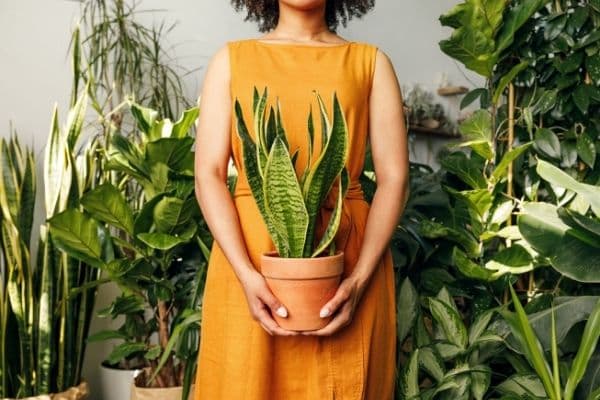How to Look After Your Houseplants at Uni
07 September 2021 • 7 min read
Here's how to look after your houseplants as a student, so they can thrive!
There’s nothing like a little greenery to brighten your living space.
Whether you’re settling into halls or you've just moved in to your new student pad, houseplants are the finishing touch that helps to bring some extra decor to your digs. Several studies have shown that indoor plants keep you happier and healthier, helping to boost your mood, lower stress and reduce fatigue.
Honestly? Rearing plant babies can be a tricky business. From overwatering to under-watering, it seems like every plant comes with its own set of complex rules to keep it alive and thriving.
That said, you don’t have to be a fully qualified, green-fingered botanist to keep a few houseplants at uni. If you’re eager to keep your student home looking fresh and green this year, read on for our top ten tips on how to look after a houseplant.
Water as needed 🚰
Keeping a plant alive is very different to keeping a pet alive. Obviously, they need hydration, but overwatering is one of the main causes of houseplant death. Rather than systematically watering your plants on your way out the door each day, it’s best to give them a drink on an as-needed basis.
Generally speaking, indoor plants in well-drained soil and the right pot should be watered when the top ½ to 1 inch of soil feels dry. Dip your finger in the soil once a week and judge for yourself whether your plant needs a drink.
Choose an area that gets plenty of natural light 🌞
When you’re decorating your room, it’s hard to think about anything but aesthetic. But, if you’re planning on keeping houseplants, sitting them on a high-up shelf or shadowy corner won’t be good for them. Remember, plants need sunlight to perform photosynthesis and make their own food.
Every plant is different, but all houseplants should get a healthy dose of natural sunlight every day – we’re talking at least five to six hours a day, preferably more. Windowsills are ideal for small plants, but if there isn’t enough space, it might be worth getting a small table to sit in front of the window and house your plants.
Top tip: If your leaves look deflated, you might be giving them too much light (plants can get sunburnt too)!
Don’t move your plants around too much 🌱
Just like we humans, plants take a bit of a time to adjust to new environments. So, if you’ve been keeping it in a shaded area and want to give it more sun, don’t make any drastic changes just yet. If you want to move it to your windowsill, introduce it to a well-lit area for an hour a day.
This way, you teach your houseplant to get used to its new environment little by little, and it won’t be negatively affected by dramatic changes in light and temperature.
Keep the room humid 💧
As the weather gets colder, you’ll inevitably be heating your home a lot more. However, while houseplants love heat, they hate dry air, so you’ll need to keep the humidity in the room up.
There’s no need to invest in an expensive, state-of-the-art humidifier – instead, add a layer of pebbles to a tray, then set the pots on the pebbles. Fill the tray with water halfway up the pebbles, making sure the pots aren’t sitting directly in water. Empty, rinse and refill the tray regularly to make sure it doesn’t attract insects and you’ll have a healthy, humid environment for your houseplants!
Choose the right pot 🏠
Just like the ideal student home, the perfect pot for your houseplant should be spacious and allow enough room for your plant to settle in and spread out. That in mind, you’ll want to choose a pot that's at least one or two inches larger than the pot you got the plant in, especially if the plant is currently in a 10-inch pot or smaller.
The planter you choose will affect how fast the soil dries out and how well a plant grows, so it’s kind of a big deal. Plastic pots are the cheapest, and they’re also the easiest to wash and reuse, but if you’ve got a top-heavy plant or a succulent, your best bet is a ceramic pot.
Prune your plants 💇
Everyone needs a haircut from time-to-time, and your houseplants are no exception. Fail to prune your plant and it’ll grow out of control! In practice, this means cutting off dead branches and stems, as these can attract bugs.
Botanists recommend removing damaged leaves, sad-looking flowers and leaving only healthy, outward-facing buds after your plant has flowered. Each type of plant will have different requirements, so do make sure to do a little bit of research to check how often you need to be trimming your plant baby.
Re-pot overgrown plants 🌾
Sometimes, houseplants outgrow their homes and need re-potting. If you can remove the plant from the pot, you might see its roots bunched up in a ball – this is what’s known as ‘root bound’, a symptom that signals your plant needs a bigger house. You might also notice roots emerging from the bottom of the pot through the drainage holes.
When you upgrade your plant’s home, you’ll also replace the soil and give your houseplant a fresh dose of nutrients. Generally speaking, plants should be re-potted once a year, unless they are slow-growing – in which case, you can get away with re-potting every other year.
Buy some good potting soil 🍄
As well as light and water, your plant babies are going to need some good potting soil. As you might have guessed, the perfect potting soil depends on the particular type of plant you’re growing. However, good indoor potting mix usually blends peat moss, a bit of shredded pine bark, perlite and super-heated minerals like vermiculite. This type of potting soil absorbs moisture well, but does tend to dry out a bit quicker.
To combat this, get yourself a spray bottle to mist your plants regularly without overwatering them. You can find potting soil and spray bottles at gardening centres, large supermarkets and even home and DIY stores.
Do a weekly houseplant health-check 🧑🏽⚕️
Looking after houseplants at uni isn’t that hard – they don’t need daily walks and constant trips to the vet, but they do need a bit of TLC. Before a week of lectures, tutorials and deadlines take up all your headspace, set aside some time on a Sunday to check up on your houseplants.
Are their leaves looking lacklustre? Is the plant wilting slightly due to dehydration? Yellow leaves could be a sign your plant needs more sunlight, while a reddish hue could be from over-exposure to the sun. Do the rounds, checking the dryness of the soil in each plant and making slight adjustments where necessary.
Get to know your houseplants 💚
Ultimately, the best thing you can do for your houseplant at uni is give it light, water and love. However, while there are a few catch-all tricks that can help promote healthy growth, it’s worth doing a bit of reading on what your houseplant needs in particular.
Succulents like cacti are a great example, as they need far less water than most due to their ability to retain moisture. Flowering plants, on the other hand, usually need a bit more water.
Before you decorate your home with your flowering friends, have a quick read up on the following:
• How big your plant will grow
• The environment it thrives in
• How often to water it
• The best soil for your plant
It doesn’t take an expert to keep a couple of houseplants thriving, but it’s better to know early on if what you’re doing isn’t good for your plant.
Time to take your house plant to your new home?🏡
Check out the availability for homes in your location on our website: www.unihomes.co.uk
That’s it from us - happy planting! 🌿




